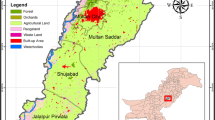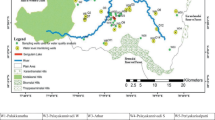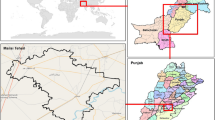Abstract
Groundwater is susceptible to pollutants. Contamination occurs when human products such as gasoline, oil, and sewage get into the groundwater and cause it to become unsafe for human use. In the last 15 years, Wadi Bani Malik has become a highly polluted area due to the disposal of sewage water in the Al-Musk area. This area has been subjected to environmental hazards, and the groundwater is the most vulnerable to the pollution. The degree of pollution can be determined from the analysis of arsenic (As). In this investigation, solute transport modeling is conducted using the finite difference method implicitly with the backward in time and center space (BTCS) technique. The model solution is in good agreement with the analytical solution. More importantly, when the model is compared with the observed As samples, it shows a strong correlation > 0.8. The model predicts the movement of the contaminants in the groundwater beginning from the starting day of installation of the land fill, showing that the plume will only travel about 16–20 km in 40 years. By that time, less than about 30% of the concentration in groundwater will be subjected to decay (diluted). However, it is difficult to fully explain the real concentration rate of change in the Al-Musk area towards the groundwater because between 2000 and 2011, the pollution was considered as a continuous source, but after that, the disposal of sewage in Al-Musk Lake has mainly stopped. So, the behavior of the lake is now defined as a discontinuous point source function.









Similar content being viewed by others
References
Al-Sefry S, Şen Z (2005) Groundwater rise problem and risk evaluation in major cities of arid lands-Jeddah case in Kingdom of Saudi Arabia. Water Resources Manag 1(20):91–108
Baalousha H (2016) Fundamentals of groundwater modeling. In: König LF, Weiss JL (eds) Groundwater: modelling, management and contamination, Chapt 4. Nova Publisher, pp 113–130
Elfeki A, Ewea H, Al-Amri N (2011) Linking groundwater flow and transport models, GIS technology, satellite images and uncertainty quantification for decision Main: Buraiman Lake case study Jeddah, Saudi Arabia. IJWRAE 1(4):295–303
Ewea HA (2010) Hydrological analysis of flooding wastewater Lake in Jeddah, Saudi Arabia. JKAU: Met, Env. Arid Land Agric. Sci 21(1):125–144
Fetter CW (2001) Applied hydrogeology 4th edn. Prentice Hall, Upper Saddle River
Ghoraba SM, Zyedan BA, RashwanI M (2013) Solute transport modeling of the groundwater for quaternary aquifer quality management in Middle Delta, Egypt. Alex Eng J 52:197–207
Guvanasen V, Volkers R (1983) Numerical solutions for solute transport in unconfined aquifers. Int J Numer Methods Fluids 3:103–123
Karahan H (2017) Implicit finite difference techniques for the advection–diffusion equation using spreadsheets. Pamukkale University, Faculty of Engineering, Department of Civil Engineering, 20017 Denizli, Turkey. Adv Eng Softw 9(37):601–608
MEPA (Metrology and Environ Prot Administration) (1994) Jeddah environmental study. Report B-2-04-9403, Saudi Arabia
Moore T, Al-Rehaili M (1989) Geological map of the Makkah quadrangle, sheet 21D. Kingdom of Saudi Arabia, Riyadh
Rahman F (2016) Environmental hazard evaluation of Al Misk Lake, using integrated geophysical techniques, PhD thesis, King Abdulaziz University, Jeddah
Saleem H (2017a) Environmental assessment of groundwater contamination movement in Wadi Bani Malik, Jeddah, Saudi Arabia, MSc Thesis, King Abdulaziz University
Saleem H (2017b) Environmental impacts on groundwater of Wadi Bani Malik, Jeddah, Saudi Arabia. IJSER 8(9):1658–1662
Sanjaya F, Mungkasi S (2017) A simple but accurate explicit finite difference method for the advection-diffusion equation, IOP Conf Series: Journal of Physics: Conf Series 909
Xue S, Chen S, Selim H (1997) Modeling alachlor transport in saturated soil. J Environ Qual 26(5):1300–1307
Zheng C, Bennett GD (2002) Applied Contaminant Transport Modeling, 2nd edn. Wiley Interscience, University of Alabama
Author information
Authors and Affiliations
Corresponding author
Additional information
This article is part of the Topical Collection on Geology of North Africa and Mediterranean Regions
Rights and permissions
About this article
Cite this article
Saleem, H.A., Subyani, A.M. & Elfeki, A. Solute transport model for groundwater contamination in Wadi Bani Malik, Jeddah, Saudi Arabia. Arab J Geosci 12, 148 (2019). https://doi.org/10.1007/s12517-019-4319-y
Received:
Accepted:
Published:
DOI: https://doi.org/10.1007/s12517-019-4319-y




